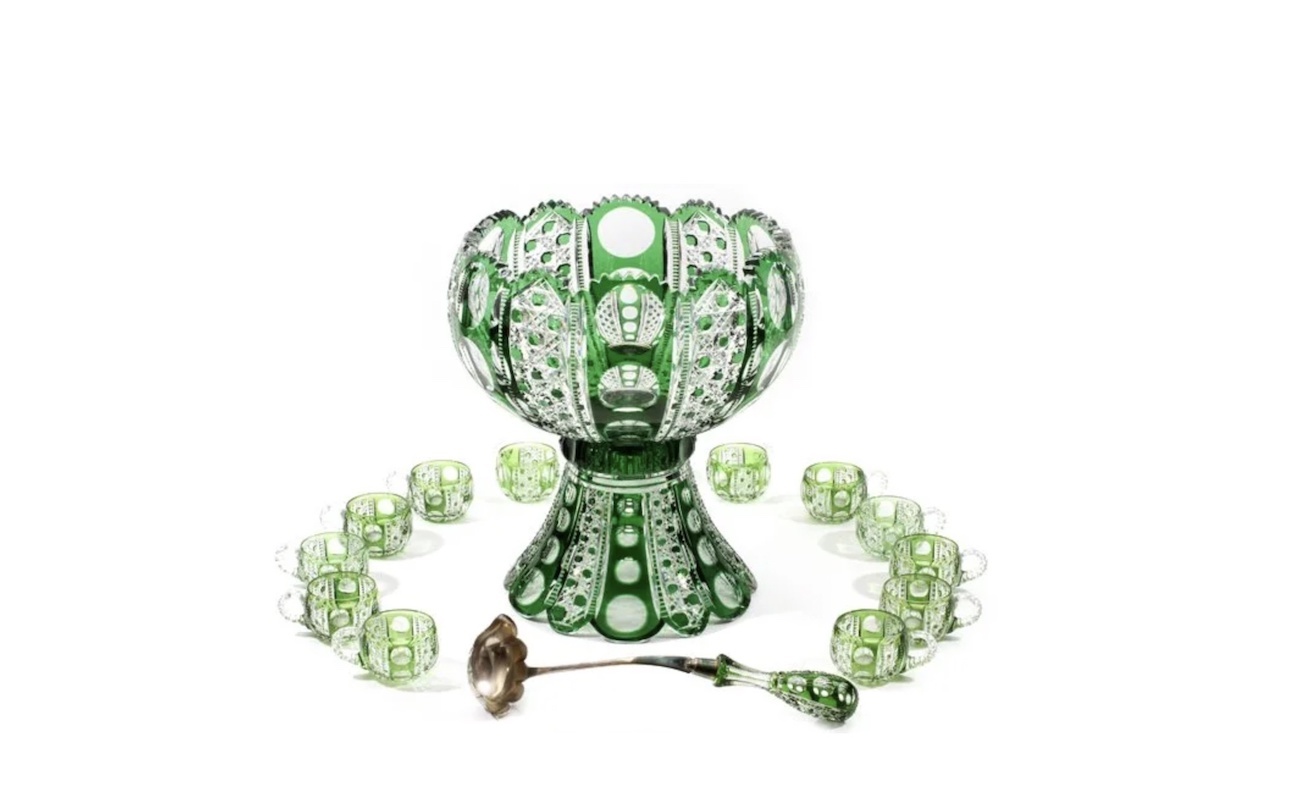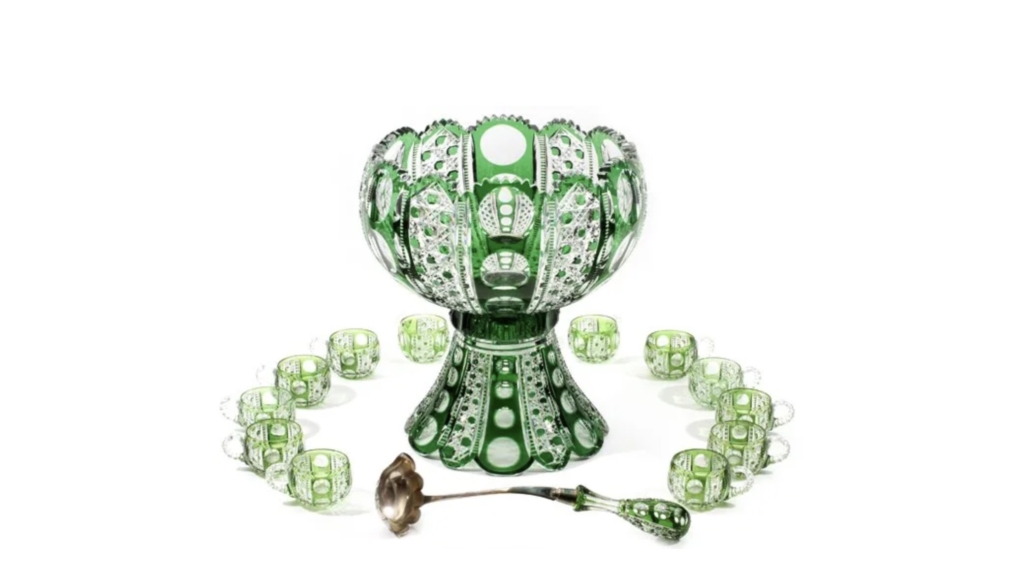
NEW YORK – Let’s make one thing clear right away: No one technically needs a punch bowl. In his delightful 2010 book, Punch, author, cocktail expert and historian David Wondrich spends a long paragraph recounting the many receptacles in which he has prepared the crowd-pleasing tipple, including, in part, “pasta pots, Le Crueset Dutch ovens, spackle buckets, salad spinners, five-gallon water-cooler jugs, candy dishes, candy jars, Lexans of all sizes, nameless orange plastic things from Home Depot, large earthenware pots, galvanized washtubs and a host of other miscellaneous vessels I’m not recalling.” But wanting a nice punch bowl has a long and honorable history. Wondrich states in Punch that the term “punchbowl” emerged by 1658 and silversmiths were producing them by 1680.
Elite artisans who practice in wildly different material realms embrace the punch bowl form for reasons that might not be obvious to the revelers who gather around them. Punch bowls are massive, and provide ample canvases for masters who want to show off their skills.
Beautifully decorated and ludicrously expensive punch bowls exist precisely because no one needs them. “Punch bowls are the largest household silver object,” said Karen Rigdon, director of decorative art and design, silver and vertu at Heritage Auctions in Dallas. “They represent the wealth of the owners and their generosity when they are put out and used.” Luxurious punch bowls enliven a party and set its tone by signaling, “Sure, we could mix and serve this festive drink out of a plastic paint bucket, but we’re more civilized than that. We’re not here to get plastered and black out. We are here to imbibe among friends.”
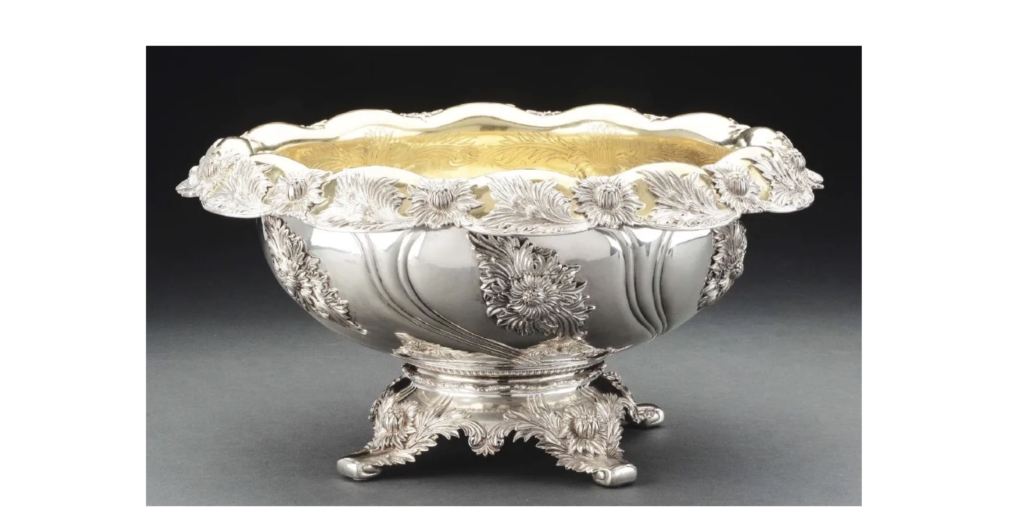
As you might expect, virtually no one collects punch bowls in and of themselves. Collectors focus on a material, such as silver or glass or porcelain; or a maker, such as Tiffany & Co. or Dorflinger; or an artistic movement, such as Arts & Crafts or Art Deco, and acquire one or perhaps two powerful examples within that context. For that matter, punch bowls are generally so large that it makes no strategic sense for a manufacturer to have several top-flight versions on display in a showroom or parked in a warehouse — they eat too much space, and they’re too labor-intensive to make on spec, aka without a committed buyer signed on.
While corporate records are, as always, spotty, it appears that most of the truly head-turning punch bowls were produced on commission, and produced as individual units without accessories. Some come with bases upon which the bowl sits or nests, but in general, punch bowls were often sold without matching ladles, trays, or cups. Great punch bowls don’t suffer when offered alone at auction, but those that happen to have extras benefit accordingly. “It matters, it matters,” said Bill Roland, co-owner of Roland Auctions NY in Glen Cove, N.Y. “A great punch bowl, sold alone, will command a respectable price. Add a ladle and 18 to 24 little glasses, when all of that’s in place, the bowl itself doubles and triples. A $2,500 punch bowl becomes $8,000 to $10,000 when it has everything with it.”
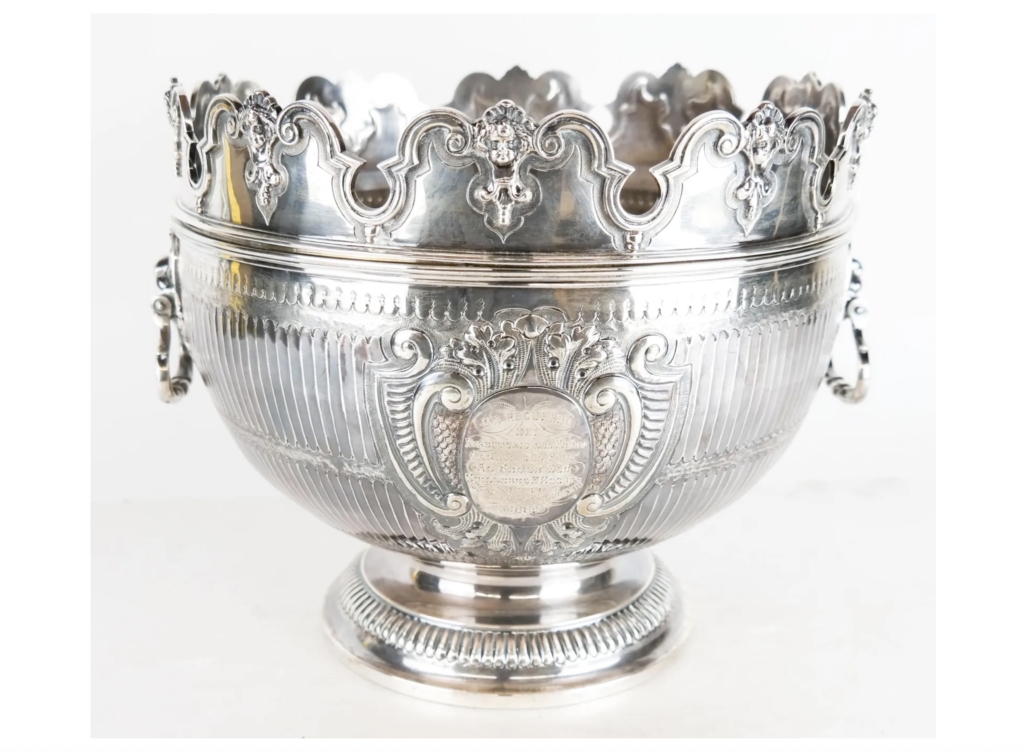
Roland estimates he has handled hundreds of punch bowls since launching his auction business in 1973, and recently sold an 1884 English silver punch bowl for $4,000 plus the buyer’s premium. It had a monteith design, a type that boasts crenellations along its rim for cooling wine glasses. After the vessel was filled with cold water, drinkers would place their wine glasses in notches in the bowl’s rim with the bodies submerged and the footed stems sticking out. Roland said the silver punch bowl’s distinctive top, which is removable, is his favorite detail: “The crown is what caught my eye. It’s like the top of a Christmas tree, the final touch.”
Peter Thomson, an expert in the fine and decorative arts division at Dan Morphy Auctions in Denver, Pennsylvania, has seen shifts in collectors’ aesthetic preferences. “As far as design goes, there was always demand for both plain and decorated bowls years ago. Now the balance has swung towards the more decorated,” he said. “This goes back and forth and depends also on the region of the country, and on the age group of the buyers.” In June of 2018, Morphy’s sold a Tiffany & Co punch bowl in the popular Chrysanthemum silver pattern for $22,500 plus the buyer’s premium. “The bowl is a good example of the various skills that go into the creation of a piece of silver like this,” he said. “The body was hammered out into the shape of a round bowl and then given the bulges and grooves you see in the photo. The chrysanthemum decoration was cast separately and soldered on to the rim. It feels as heavy as it looks when picking it up.”
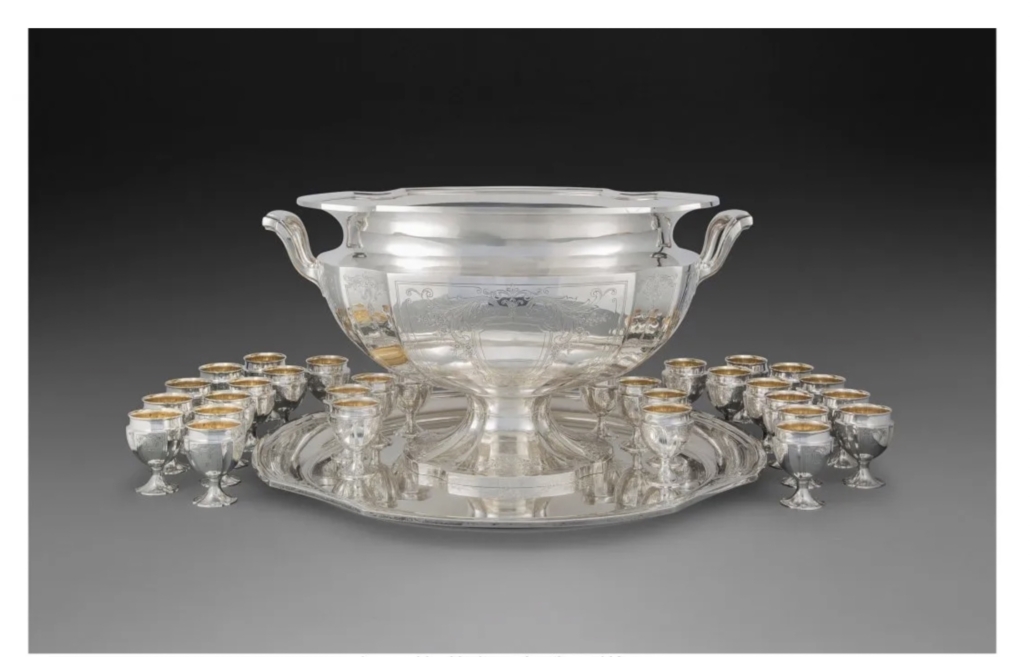
Weight is a topic that inevitably arises when discussing collectible punch bowls. No matter what they’re made from, they’re heavy, and when filled with liquid, they’re heavier still. Punch bowls made from silver might be the heaviest of all. Rigdon will never forget a 32-piece partial-gilt silver Reed & Barton punch service she sold at Heritage in November 2020 for $22,000 plus the buyer’s premium, not least because it contained 836.3 troy ounces of the precious metal. “It was incredibly unusual to have a punch bowl of this size,” she said. “That’s a huge amount of silver. Picking it up was an incredible experience.” She added that its 30 matching cups were “also substantial, and the width of the silver was quite thick. Each goblet duplicates the form of the punch bowl, and each is very beautifully engraved. When you pick one up, it feels like having something massive in hand.”
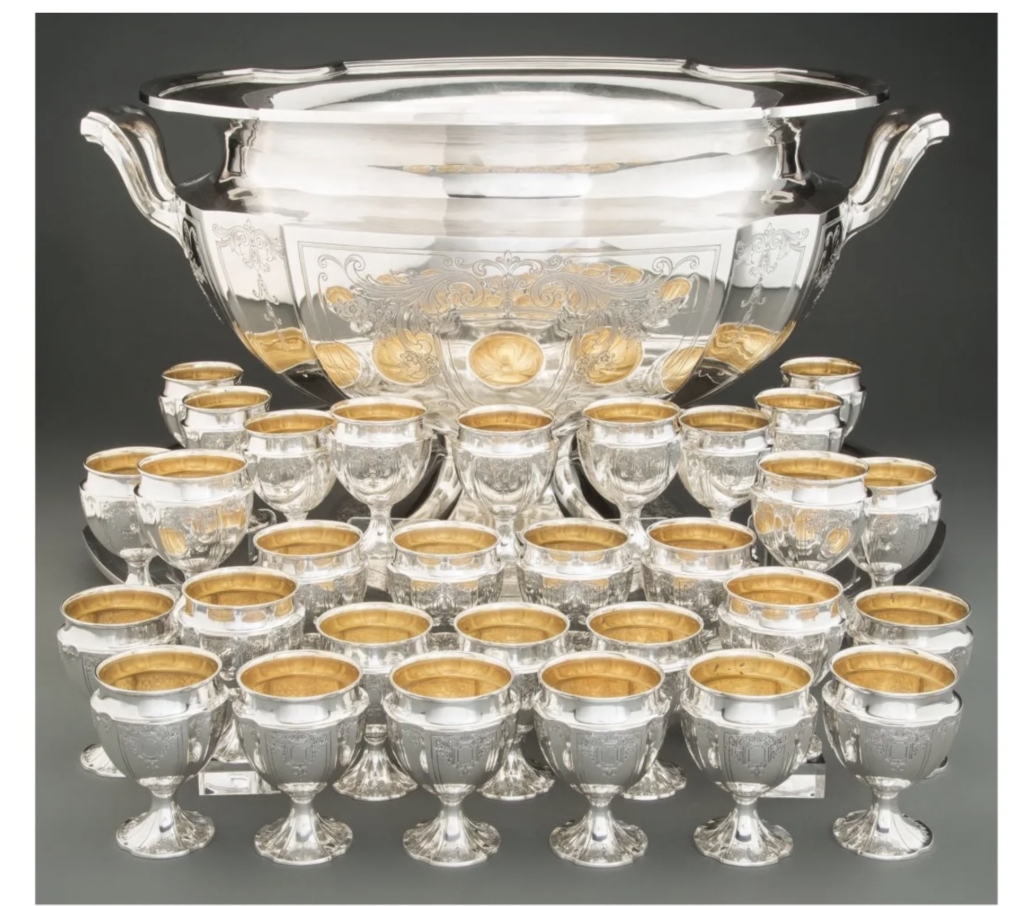
The very existence of the Reed & Barton punch service posed questions that neither Rigdon nor any other expert has managed to answer. It must have been crushingly expensive, yet it dates to 1933 — the height of the Great Depression. Weirder still, the person or entity that splashed out on the commission chose not to mark it as theirs. Rigdon says it was tested for signs of monogram removal, and there’s no evidence it ever had any monograms. She searched archived newspaper coverage of socialites’ fetes and similar events in hopes of finding mention of the punch service with no luck. “1933 is a very odd time for this to have been made. You just don’t get anything comparable size-wise during this period. They should have at least signed their name on the bottom,” she said. “If you’re going to do a real stunt piece, you create it and melt it, or you archive it in one way or another. I can’t come up with a reasonable explanation [for why it was made.] But it’s fun to own a mystery.”
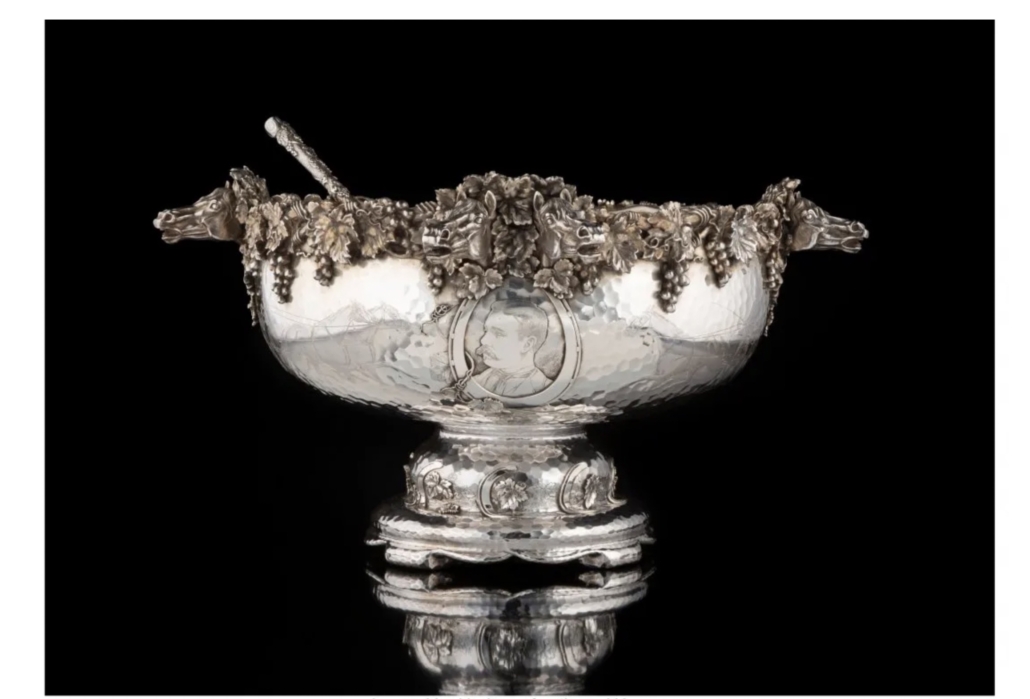
The same November 2020 Heritage sale featured a second jaw-dropping punch bowl set that was far better documented. The Tiffany & Co. partial-gilt silver punch bowl and ladle dated to 1881 and was recorded in the firm’s logbook, with the bowl and ladle sharing the same production number. The exquisite piece, which had been commissioned as a trophy, sold for $95,000 plus the buyer’s premium.
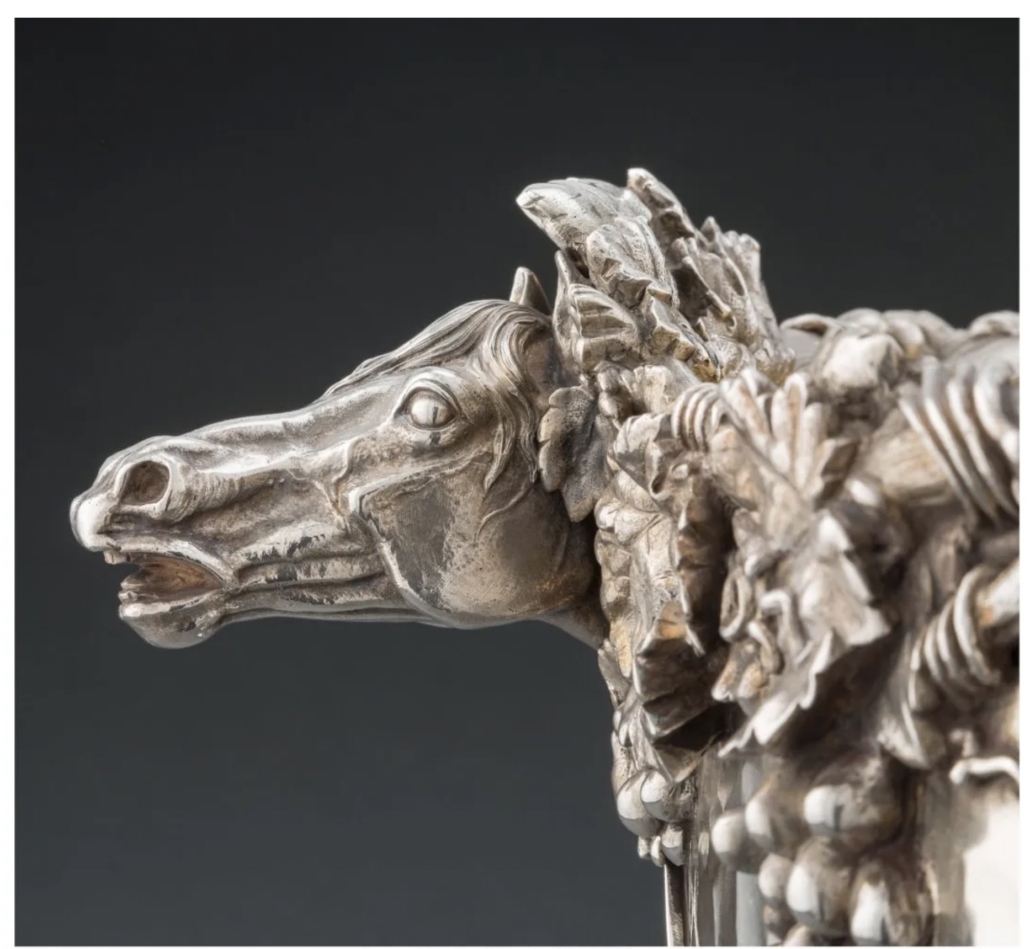
“The whole thing has a wonderful hand-hammered surface inside and out, with grape vines jutting into and below the engraving,” she said. “The horse heads also jut out. I don’t think the photos can show you the extent of it. There’s thick surface acid-etching, and the thickness is very clear. There’s so much going on, layer upon layer. The closer you get, there’s more you see, and it reveals itself slowly.” It was definitely designed to be used, as Rigdon learned in her newspaper archive research of the lot: “It can hold three and a half cases of Champagne, and that would make it only three-quarters full.”
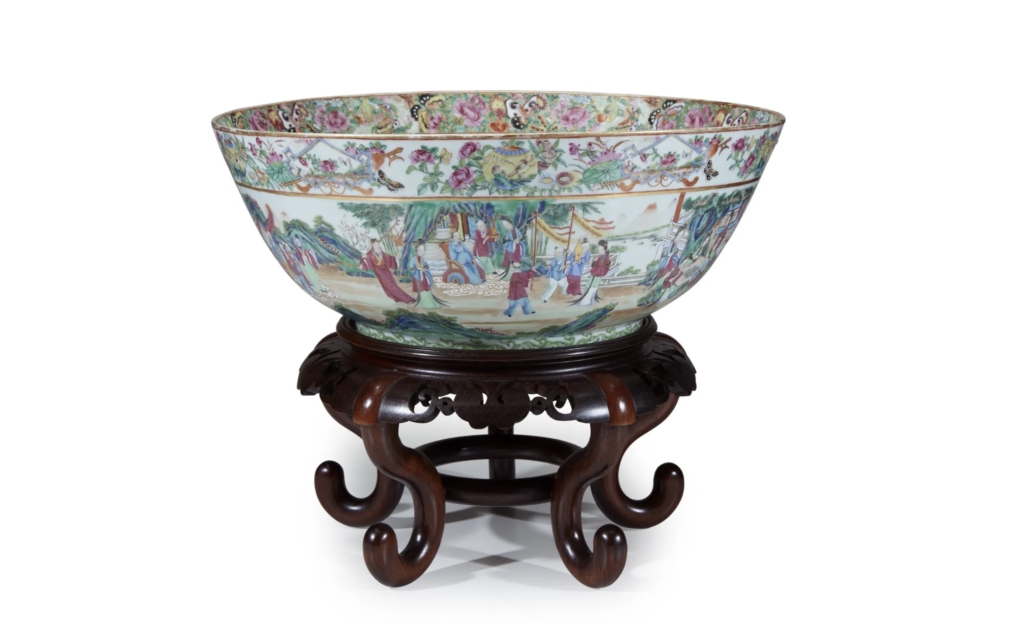
Masters of porcelain have worked their magic on the punch bowl form as well. In July 2020, Freeman’s sold a 19th-century Chinese Export rose mandarin punch bowl on a wooden stand for $11,000 plus the buyer’s premium, a sum that easily exceeded its $2,000-$3,000 estimate. Laura Sevelis, head of sale for British and European furniture and decorative arts at the Philadelphia auction house, explained, “One important factor is this piece’s size. It has a diameter of 20 ¾ in, so it is quite large and impressive. Additionally contributing to its performance is how finely painted it is, and that it had no notable condition issues.”
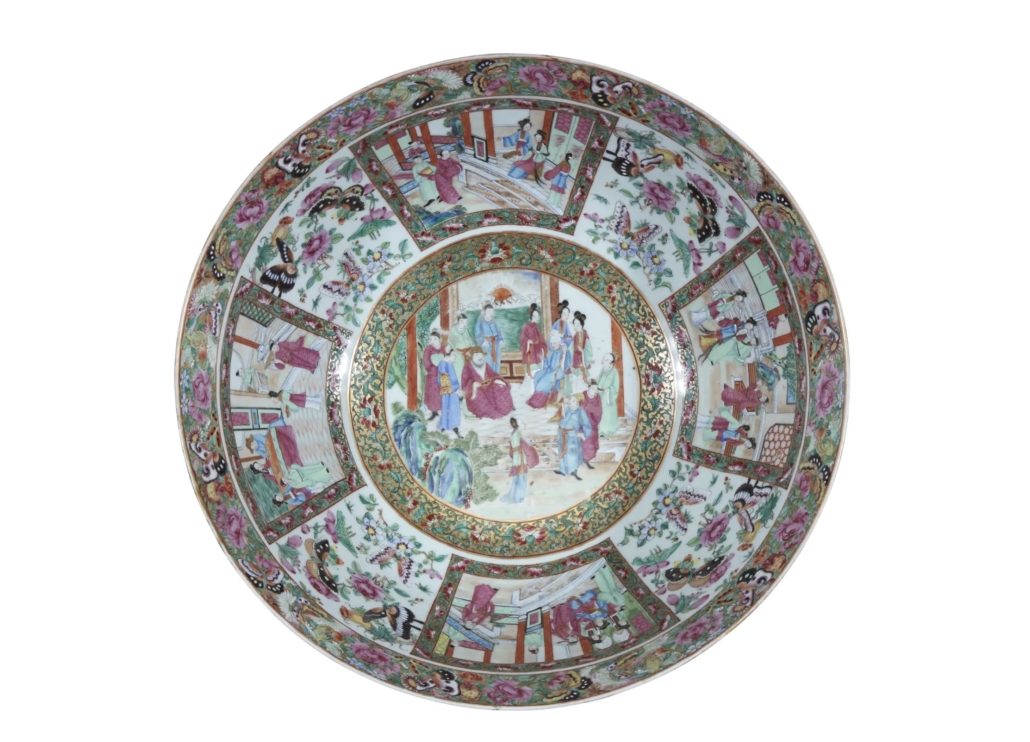
She added that its “condition indicates it likely, at least occasionally, functioned as a punch bowl.” The fact that the Chinese Export porcelain bowl seems to have been used makes the care and labor devoted to its painted decoration, which extends to the interior of the bowl, all the more stunning. The artists knew their work would be concealed by liquid exactly when it would have its largest audience, and yet they went ahead anyway.
Brilliant cut glass punch bowls dating to the turn of the previous century are a different animal altogether, and the finest are even more magnificent than their flamboyant silver and porcelain cousins. Joan Walker, president of the DuMouchelles auction house in Detroit, Michigan, said, “Punch bowls are for special occasions. They have a large capacity. You don’t haul out a punch bowl when you have an intimate group. They’re meant for important celebrations.”
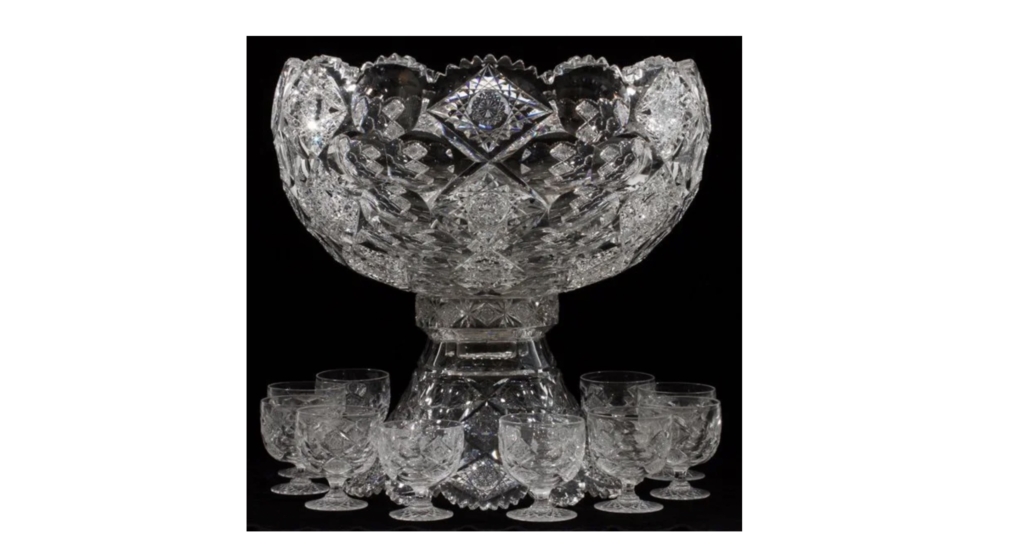
Walker handled a peerless glass collection from an Ohio estate in September 2014. Her reverence for the punch bowl sets within the group remains fresh and radiant years later. Speaking of a circa-1900 Brilliant cut clear glass punch bowl set by Hawkes that realized $17,000 plus the buyer’s premium, she said, “When you see a piece of Hawkes crystal, you look twice. It’s very beautifully cut, very intricate, like you’re looking at diamonds. Just profusely cut. It doesn’t end.”
The circa-1900 Montrose pattern green-to-clear punchbowl set by Christian Dorflinger was a no-brainer for the 2014 auction’s catalog cover. “We knew it was valuable. We certainly gave it a lot of promotion. We knew it would find its level,” she said. It ultimately achieved $110,000 plus the buyer’s premium against an estimate of $10,000-$15,000.
“No, I didn’t expect that much,” she said, stating she thought it would go for $60,000 to $70,000. “But that just shows its rarity. You won’t find another like it easily. Most cut glass is clear. Colored glass, I think, is in greatest demand, and it’s more usual to get cranberry to clear. Green can be very tricky. This punch bowl was an emerald green, and intense throughout. From its inception, it was important because it was so labor-intensive and beautiful.”
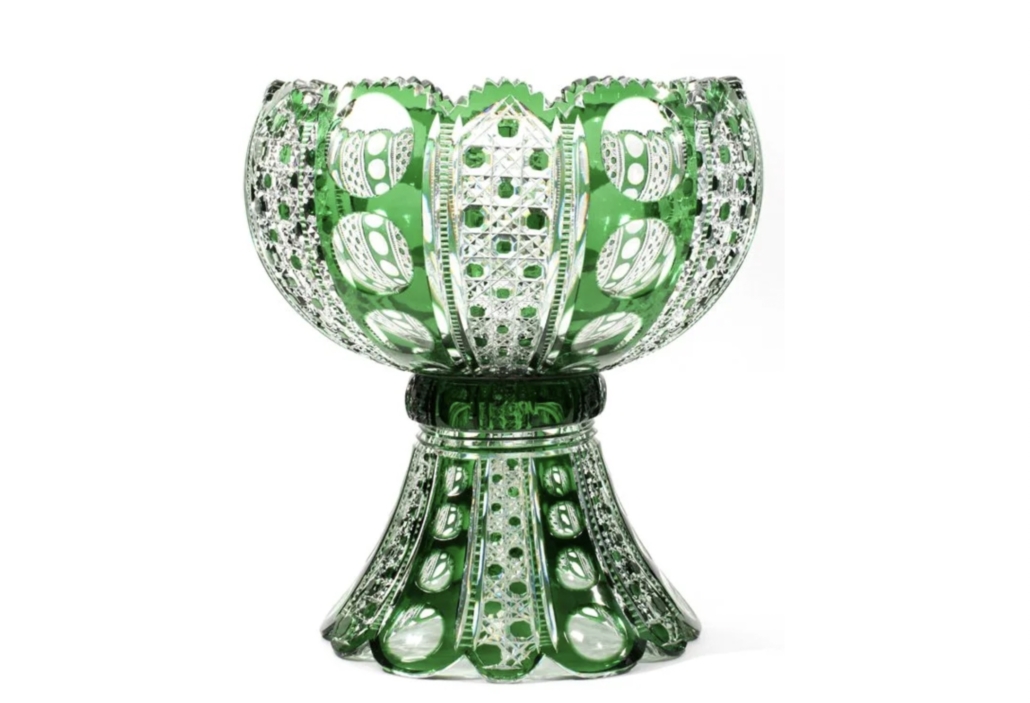
The Dorflinger set was a two-piece design, with a bowl that locked into a base (the green waistline or belt visible in the photos represents the joining point). It also had its matching ladle and 13 cups of a style that Wondrich describes, cheekily, as a “knuckletrap.” While the Dorflinger set’s complete trajectory is unknown, it’s reasonable to infer it originally must have come with more than 13 cups. The number 13 was stigmatized around 1900, and more to the point, punch bowls are patronized by partiers. Punch cups are intentionally small to force guests to mingle by approaching and returning to the punch bowl, and the size also limits their intake, as the host’s recipe could be unforgivingly strong. When drunks are given dainty little pieces of glass and let to wander, bad things happen.
Obviously, the curious number of punch cups didn’t dampen the set’s performance. When asked how it might do if she had it back today, Walker laughed and said, “Probably better than it did then, because it’s so rare… The Dorflinger punch bowl is a whole different tier, like the top of the mountain. It is to be admired or looked at. I would never use it.”
But punch bowls are meant for special occasions. What if the Pope or the president or the head of the United Nations paid the honor of a visit? Would Walker dust off the prize Dorflinger punch bowl set for them?
She paused.
“I’d have them just look at it.”


